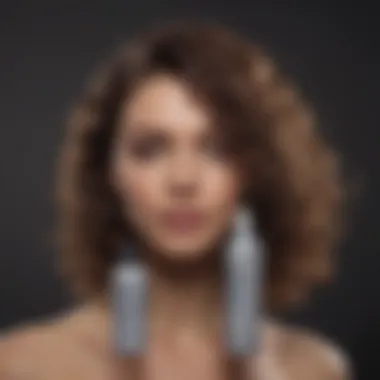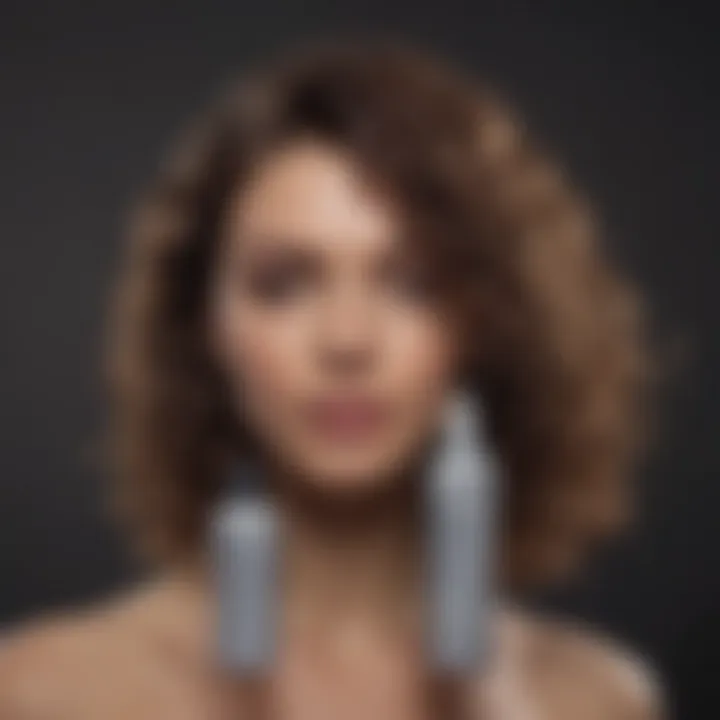Repairing Heat Damaged Curly Hair: A Comprehensive Guide


Intro
Curly hair, with its unique texture and volume, can be both a gift and a challenge. One of the significant challenges is heat damage. High temperatures from styling tools can strip curls of their natural vitality, leading to frizz, breakage, and loss of definition. Understanding the intricacies of heat damage can help in formulating a recovery strategy. This guide outlines effective methodologies and products that aid in repairing heat-damaged curly hair. By recognizing what causes this damage and applying targeted treatments, individuals can return their curls to a state of health that both preserves texture and enhances manageability.
Beauty Tips and Tricks
Skincare Routine Tips
Healthy hair starts with healthy skin. The scalp's condition plays a crucial role in hair health. Consider the following tips:
- Gentle Cleansing: Use a mild shampoo that suits curly hair to avoid stripping essential oils from both scalp and hair.
- Moisturizing Conditioner: Incorporate a deep conditioner that penetrates the hair follicles to nourish and hydrate.
Haircare Hacks
Repairing heat-damaged curls requires some nuanced techniques:
- Reduce Heat Exposure: Limit the use of straighteners and curling irons. When using these tools, always apply a heat protectant.
- Air Drying: Whenever possible, allow your hair to air dry rather than blow-drying. This minimizes exposure to damaging heat.
- Protective Styles: Opt for braids or buns to reduce manipulation and protect hair from further heat damage.
Makeup Application Techniques
While this guide focuses on hair, an overall beauty regimen enhances your entire look. Here are a few makeup application techniques:
- Use lightweight products to avoid a heavy feeling on your skin, especially when dealing with damaged hair.
- Highlight your eyes or lips to draw attention away from any hair issues.
Expert Beauty Advice
Professional Makeup Artist Insights
Professional makeup artists often suggest that clients embrace their unique textures. Curly hair can be styled in numerous ways that can enhance one’s overall appearance. They also emphasize:
- Highlight Curls with Colors: Utilizing color treatments can accentuate the natural curls and give them dimension.
Skincare Specialist Recommendations
Skincare experts note that caring for the scalp is just as essential as caring for the hair. Recommendations include:
- Exfoliation: Regularly exfoliate the scalp to remove dead skin cells, which can promote better hair growth.
Hair Stylist Tips
Hair stylists advocate for regular trims. Keeping the ends healthy encourages overall growth, avoiding split ends, which can worsen heat damage. They also recommend using treatments rich in proteins and moisture, as these can significantly aid recovery.
"Caring for curly hair after heat damage requires patience, but restorative methods can yield impressive results over time."
Product Reviews
Haircare Product Reviews
Several products claim to restore heat-damaged curls, but effectiveness can vary:
- Olaplex No. 3: Known for its bond-building properties, this treatment can remarkably resurrect damaged hair.
- SheaMoisture Coconut & Hibiscus Curl Enhancing Smoothie: This product offers moisture and shine, providing the perfect combination for curly hair recovery.
Understanding Heat Damage
Understanding heat damage is crucial for effectively recovering and maintaining the health of curly hair. Heat damage occurs when excessive heat from styling tools, such as flat irons, curling wands, or blow dryers, weakens the hair structure. This guide emphasizes the importance of recognizing and addressing heat damage due to its long-term effects on hair health, particularly for those with curly hair. Curly hair is naturally more prone to dryness and damage. Therefore, comprehending the implications of heat exposure can help individuals make informed decisions about hair care.
What is Heat Damage?
Heat damage refers to the detrimental effects caused by high-temperature styling methods. When hair is exposed to heat, the temperature can surpass the optimal threshold for hair health. Hair comprises keratin, which can become brittle and lose moisture when subjected to heat. This change can lead to a breakdown of the hair fibers, resulting in weakened strands. Often, heat damage manifests as dryness, frizz, and loss of curl definition. The extent of damage depends on several factors, such as the temperature of the styling tool, duration of exposure, and the initial condition of the hair.
How Heat Affects Curly Hair
Curly hair is uniquely structured and can be more challenging to maintain than straight hair. When heat is applied, it alters the natural curl pattern. This impact is particularly pronounced with high heat. The cuticles, which serve as the protective barrier of each hair strand, can lift and become damaged, leading to increased porosity. With higher porosity, hair loses moisture quickly, making it susceptible to further damage. The relationship between heat and moisture is vital for curly hair. Excessive heat combined with a lack of moisture can result in unmanageable curls, making them appear frizzed or flat.
Signs of Heat Damage in Curly Hair
Recognizing the signs of heat damage is essential to prevent further deterioration of hair health. Some common indicators include:
- Dryness: Curly hair may feel brittle or have a rough texture.
- Frizz: Increased frizz can occur when the cuticle is damaged.
- Loss of Curl Pattern: Curls may become limp or lose definition.
- Split Ends: Heat damage often leads to frayed or split ends, which require trimming.
- Breakage: Excessive heat can weaken hair strands, making them prone to snapping.
"Immediate recognition and intervention are key to managing heat damage effectively."
Addressing these symptoms promptly can help mitigate further damage and restore the curls to their natural beauty. In summary, understanding heat damage provides a solid foundation for implementing effective recovery strategies, ensuring that curly hair maintains its integrity and vibrancy.
Identifying Your Curl Type
Understanding your curl type is a fundamental step in repairing heat-damaged curly hair. Each curl type possesses distinct characteristics and requires specific care techniques. Recognizing these differences enables you to tailor your hair care regimen effectively.
The Different Types of Curls
Curls can be categorized into several types based on their shape and texture. Generally, they fall into four main categories: 1A, 1B, 1C, 2A, 2B, 2C, 3A, 3B, 3C, 4A, 4B, and 4C.
- Type 1: Straight and doesn't curl.
- Type 2: Wavy with a slight wave or form.
- Type 3: Curly, ranging from loose loops to tighter coils.
- Type 4: Kinky or coily, often with a zigzag pattern.
Identifying your specific curl type can significantly impact your approach to restoration. For instance, tighter curls like 4B may require heavier creams for hydration, while looser curls assess a lighter mousse or spray.
How Curl Type Affects Damage Recovery
Curl type plays a crucial role in how hair recovers from heat damage. It influences absorption rates of moisture and the effectiveness of various treatments. For example, tighter curls typically absorb products slower due to their shape, which can lead to a build-up of products if not managed properly. Conversely, looser curls might need products that penetrate more quickly.
Here are some considerations for each curl type:
- Type 3 Curls: Often require protein treatments along with moisture. These curls are more prone to frizz but can rebound well with proper care.
- Type 4 Curls: These can endure significant styling damage but also showcase the most resilience when hydrated adequately. Regular moisturization is vital.


Remember to regularly assess your hair's response to treatments according to your curl type. Adjustments may be necessary based on ongoing results and needs.
By understanding your curl type and its impact on recovery, you will be better equipped to formulate an effective hair care routine.
Immediate Steps to Take
Addressing heat damage in curly hair demands prompt action. Taking immediate steps not only mitigates the impact of the damage but also sets the foundation for effective recovery. The right initial approach can often determine the overall success of restoring the hair’s natural texture and vitality. Focusing on two key aspects—assessing the damage and creating a damage control plan—can significantly enhance the repair process.
Assessing the Damage
Before any treatment can begin, it is crucial to accurately evaluate the extent of heat damage. This means examining the hair's physical state and understanding how it has been compromised. Signs of damage may include increased dryness, brittleness, and split ends. Often, curls may lose their definition, appearing limp or frizzy instead.
To conduct an effective assessment, consider the following steps:
- Visual Inspection: Look for any noticeable changes in texture or color. Uneven curl patterns or excessive frizz are common indicators of heat damage.
- Texture Test: Run your fingers through your hair. If the strands feel rough or look dull, this suggests a lack of moisture and protein balance.
- Stretch Test: Carefully pull a few strands to check their elasticity. Healthy hair will stretch and return to its original shape. Hair that breaks easily or does not return might be over-processed or severely damaged.
Taking these steps will provide a clearer picture of your hair's health, enabling more targeted treatment.
Creating a Damage Control Plan
Once damage has been assessed, the next step is to create a comprehensive damage control plan. This plan should not only focus on repairing your curls but also on preventing further damage in the future.
Key elements to include in your plan are:
- Moisturization: Incorporate hydration as a central point of your regimen. Frequent deep conditioning treatments will offer hydration and help restore balance.
- Protein Treatments: Identify suitable protein treatments appropriate for your hair texture. These will help in rebuilding the strength of the hair strands.
- Gentle Cleansing: Select sulfate-free shampoos that cleanse while retaining essential moisture. Avoid harsh ingredients that can strip your hair.
- Styling Adjustments: Modify your styling routine to minimize heat exposure. Embrace heat-free methods as much as possible to protect your curls.
- Regular Monitoring: Track your hair’s condition over time. Adjust your plan based on how your hair responds to treatments and changes.
Important Consideration: A personalised approach is recommended. Everyone’s hair is different, and what works for one person may not work for another. Regularly assess and adapt your plan based on your hair’s unique needs.
By conducting an honest assessment and establishing a tailored damage control plan, you can initiate the healing process for your curly hair effectively. Both actions are pivotal in helping you navigate the path towards healthier and resilient curls.
Hydration and Moisture Restoration
Hydration is critical in the recovery process for heat damaged curly hair. Curly hair has a unique structure that makes it more susceptible to moisture loss. When the hair cuticle becomes damaged from heat, it leaves the strands unable to retain moisture effectively. This can lead to dryness, brittle strands, and frizz, all of which are undesirable. Thus, reintroducing moisture is not just beneficial; it is essential for restoring the natural health of your curls.
Maintaining adequate moisture levels promotes strength and elasticity, reducing the risk of further damage. Curly hair types can appear shapeless or limp when dehydrate, leading to an unkempt look. On the contrary, when properly hydrated, curls regain their definition, bounce, and overall vitality.
Importance of Moisture for Curly Hair
Moisture serves as the foundation for healthy hair. For curly hair, moisture helps in several aspects:
- Improved Elasticity: Properly hydrated curls stretch without breaking, allowing for styling versatility.
- Reduced Frizz: Moisture helps in balancing the hair’s natural oils, combating frizz effectively.
- Enhanced Shine: Hydration promotes a natural sheen, which is often sought after in curly styles.
- Preventing Breakage: Well-moisturized hair is less prone to splitting and damage, prolonging the life of your curls.
Those with curly hair should understand that hydration is not a one-time fix but a continuous commitment. Regularly moisturizing the hair aids in fortifying it against future damage.
Recommended Moisturizing Products
Selecting the right moisturizing products is key to restoring hydration to curly hair. Look for products that contain:
- Natural Oils: Ingredients such as coconut oil, shea butter, and argan oil can deeply nourish.
- Humectants: These ingredients, like glycerin and honey, draw moisture from the air, helping to keep hair hydrated.
- Protein: Lightweight proteins can restore strength while helping to maintain moisture balance.
A few recommendations include:
- Maui Moisture Curl Quench + Coconut Oil Shampoo: Gentle and hydrating, ideal for dry curls.
- Cantu Shea Butter Leave-In Conditioning Repair Cream: Good for daily moisturization.
- Ouidad Moisture Lock Leave-in Conditioner: A lightweight option that helps retain moisture throughout the day.
In your quest for hydration, testing different products may be necessary as not every product suits every hair type.
DIY Hair Masks for Extra Hydration
Creating a DIY hair mask is another great way to enhance moisture in curly hair. Natural ingredients are often accessible and can offer effective results. Consider these recipes:
- Avocado and Honey Mask:
- Banana and Coconut Milk Mask:
- Olive Oil and Yogurt Mask:
- Mash one ripe avocado.
- Combine with two tablespoons of honey.
- Apply to damp hair, leave for 30 minutes, then rinse.
- Blend one ripe banana with half a cup of coconut milk.
- Apply to hair and leave for 20 minutes before washing out.
- Mix two tablespoons of olive oil with half a cup of yogurt.
- Apply to dry hair for 30-45 minutes, then rinse thoroughly.
These masks can be done once a week for optimal results. Hydrating treatments will ensure curls stay bouncy, defined, and healthy.
As you move forward in your journey of hair restoration, focus on hydration and moisturizing regularly. This dedication is crucial for long-lasting recovery from heat damage.
Protein Treatments for Repair
In addressing the issue of heat-damaged curly hair, protein treatments play a vital role. Curly hair, by its nature, requires specific care and restoration methods due to its structure and the way it reacts to damage. Heat can strip the hair of its essential proteins, leading to weak, brittle strands. This section elaborates on the significance of protein treatments, providing clarity on how they contribute to hair health.
Role of Protein in Hair Health
Proteins are the building blocks of hair. They form the structure of each hair strand, offering strength and resilience. When hair is subjected to excessive heat, it loses these proteins, which can cause frizz, breakage, and a lack of defined curls. Protein treatments can help restore the integrity of hair by replenishing lost proteins, thus improving overall hair texture.
Hair types vary in how they respond to protein. Curly hair often benefits from protein treatments because the coils and curls need specific support to maintain their bend and elasticity. When curly hair is well-protected by adequate proteins, it can withstand environmental stressors better and continue to showcase its natural beauty.
Choosing the Right Protein Treatment
Selecting a protein treatment that aligns with your hair’s needs is essential. Not all protein treatments are the same; they serve different purposes based on the hair’s current condition. Here are a few considerations:
- Identify Hair Type: Understanding whether your curls are fine, medium, or coarse can help you select a more suitable product.
- Ingredients: Look for treatments that contain hydrolyzed proteins such as keratin, silk, or wheat. These proteins penetrate hair more effectively compared to others.
- Form: Treatments come in various forms—masks, sprays, conditioners. Choose one that fits well into your hair care routine.
- Protein Retention: For damaged hair, a balance of protein and moisture is crucial. Some products are aimed at rebuilding while adding moisture.
Applying Protein Treatments Correctly
Application of protein treatments should be done thoughtfully to maximize benefits. Here are key steps:
- Assess Damage: Prior to applying the treatment, evaluate your hair’s condition to determine the level of protein required.
- Follow Instructions: Each product will have specific guidelines. Adhere to the recommended duration and frequency to avoid overuse, which can lead to stiffness.
- Even Application: Distribute the treatment evenly from roots to ends. This ensures that every strand receives adequate support.
- Follow Up with Moisture: After rinsing out the protein treatment, apply a moisturizing product. The combination helps in maintaining balance within the hair structure.


A well-rounded protein treatment plan can significantly improve the texture and resilience of heat-damaged curls, restoring them to their full potential.
"Protein treatments can be a key component in rejuvenating your curls, offering much-needed strength loss from heat exposure."
Through careful selection and application, individuals can achieve not only healthier curls but also a deeper understanding of their hair's unique needs. Utilizing protein treatments effectively fosters a positive cycle of care, ultimately leading to revitalized and bouncy curly hair.
Gentle Cleansing Practices
The cleaning process is a critical step in maintaining the health and integrity of curly hair, especially after experiencing heat damage. Gentle cleansing practices are fundamental to keep hair from becoming further damaged during recovery. Curly hair is often drier and more delicate compared to straight hair, requiring a different approach to cleansing.
Cleansing the hair properly helps to remove buildup from products, dirt, and excess oil while preserving the natural moisture. This balance is essential to revive heat-damaged curls. A harsh cleansing routine can strip away necessary oils, leading to increased dryness and brittleness.
Selecting a Suitable Shampoo
Choosing the right shampoo is crucial for curly hair recovery. Look for sulfate-free shampoos as these are less likely to dry out the hair. Sulfates are harsh detergents that might provide a deep clean but can be detrimental, especially for damaged hair. Instead, opt for gentle, hydrating formulas that focus on moisture retention.
Some recommended ingredients to search for include:
- Cocamidopropyl betaine: A mild surfactant known for being gentle yet effective.
- Natural oils: Oils like argan or jojoba nourish and repair the hair while cleansing it.
- Aloe Vera: Known for its soothing properties, it helps to hydrate the scalp and hair.
It's also advisable to avoid shampoos with added fragrances and colorants, as these can irritate the scalp and hair further. Test different products to find what works best for your hair type.
Frequency of Washing
The frequency at which you wash curly hair can greatly affect its overall health. Over-washing can lead to additional dryness and frizz. Many curly-haired individuals find that washing their hair once or twice a week is sufficient. However, this can vary based on personal preference and hair type.
Remember: Listen to your hair. Adjust your washing schedule based on how your curls respond. If they feel dry or brittle, it might be time to cut back.
In between washes, consider co-washing, which is the practice of washing hair with conditioner only. This can help retain moisture while still cleansing the hair and scalp. Regularly checking the condition of your curls will guide your cleaning habits and help you achieve the best results.
Heat Protection Strategies
Protecting curly hair from heat damage is a crucial step in maintaining its health and integrity. Heat styling tools, despite their convenience, can wreak havoc on the delicate structures of curly hair. These strategies aim to minimize potential damage while preserving the beauty and bounce of curls.
Importance of Heat Protectants
Heat protectants serve as a barrier between your hair and the intense heat produced by styling tools such as flat irons, curling wands, and blow dryers. They are designed to coat the strands, reducing the risk of moisture loss and brittleness. Applying heat protectants is not just advisable; it is essential.
Here are reasons why heat protectants are important:
- Prevents Damage: They lower the likelihood of split ends or breakage caused by high temperatures.
- Locks in Moisture: Many formulas contain humectants that attract moisture to the hair, keeping it hydrated and resilient.
- Enhances Shine: Heat protectants can also add shine, making curls look healthier and more vibrant.
- Improves Manageability: They can reduce frizz and make hair easier to style, which is especially beneficial for curly textures.
"Using a heat protectant is a simple yet effective way to safeguard your curls from heat damage."
Selecting Effective Heat Protection Products
Choosing the right heat protection product involves understanding your unique hair needs and the ingredients that will work best for your curls. Here’s a guide to help you identify effective products:
- Look for Key Ingredients: Seek products with silicone-based ingredients like dimethicone or cyclopentasiloxane, which provide a protective coating. Also, natural oils such as argan oil or coconut oil can offer added nourishment.
- Consider Your Curl Type: Different curl types have varying needs when it comes to heat protection. For tighter curls, look for heavier creams, while looser curls may benefit from lighter sprays.
- Choose According to Your Routine: If you use heat styling frequently, opt for a stronger formulation designed for high temperatures. For occasional use, a lighter protectant may suffice.
- Read Reviews and Recommendations: Researching user experiences can provide insight into the effectiveness of a product. Community feedback on platforms like Reddit can be particularly useful.
Ensuring that you incorporate an effective heat protectant into your hair care routine will bolster your curly locks against future heat exposure. Selecting the right product is key to maintaining healthy curls and allowing you to enjoy styling without the fear of permanent damage.
Styling Techniques for Damaged Curls
Styling techniques play a crucial role in the health of damaged curly hair. When hair suffers from heat damage, it becomes weaker and more prone to breakage. Therefore, adapting your styling methods is essential to minimize additional harm while enhancing the appearance of your curls. Understanding how to care for your hair while styling is integral to the recovery process, helping retain moisture and strength.
Heat-Free Styling Options
Heat-free styling methods are a necessity for anyone looking to recover from heat-damaged hair. Heat can exacerbate existing problems, causing further deterioration. Therefore, exploring alternative styling techniques is a practical approach.
Consider methods like:
- Braiding: This technique encourages natural curl patterns. By braiding damp hair, you can create waves without the need for heat.
- Twist-outs: Similar to braids, twisting sections of wet hair can help enhance curl definition.
- Bantu knots: This style provides a defined curl while giving the hair a rest from heat exposure.
These methods not only promote healthy curls but also allow individuals to express personal style while supporting hair recovery. It helps in maintaining the natural texture without introducing the risk of damaging heat.
Minimizing Styling Damage
Minimizing styling damage is as important as choosing the right styling methods. Simple adjustments can have significant impacts on hair health. Here are key practices to consider:
- Use a wide-tooth comb: When detangling, opt for a wide-tooth comb on wet hair. This approach reduces breakage and works gently through knots.
- Avoid tight hairstyles: Styles that pull on the roots can cause stress on the hair shaft, leading to further damage.
- Limit styling frequency: Give your curls time to recover by reducing how often you style them. Allowing your hair to rest aids in restoring its natural bounce and vitality.
- Incorporate leave-in conditioners: Using a quality leave-in conditioner protects hair from environmental factors and adds moisture. This step is critical for keeping curls hydrated.
By implementing these techniques, damaged curls can survive the styling routine without succumbing to further damage. It becomes not just about how you style, but about ensuring that every choice supports the journey to recovery.
Long-Term Care for Curly Hair
Long-term care for curly hair plays a crucial role in maintaining its health, particularly after experiencing heat damage. Regular attention and appropriate routines can prevent further damage while ensuring that curls remain vibrant and well-defined. The essence of long-term care lies in understanding the unique requirements of curly hair and addressing them consistently over time.
Establishing a Hair Care Routine
To effectively restore and maintain the integrity of curly hair, establishing a solid hair care routine is essential. This routine should incorporate key elements such as washing, moisturizing, and styling methods tailored to curly hair. The following points are critical for creating a beneficial hair care regimen:
- Frequency of Washing: Curly hair tends to be dryer than straight hair due to its structure. Washing hair too frequently can strip away its natural oils, leading to increased dryness. It's advisable to wash curly hair every 5 to 7 days, allowing enough time for oils to nourish the scalp and strands.
- Moisture Retention: Moisturizing is key to keeping curls hydrated. Incorporating leave-in conditioners or hydrating creams can be beneficial. Find products that are rich in ingredients such as aloe vera or glycerin, which help maintain moisture.
- Gentle Styling: Avoid tight hairstyles and heat styling tools. Instead, embrace methods like braiding or twisting to encourage curl formation without introducing more damage.
- Product Build-Up: Regularly clarify your hair to remove product build-up. Look for sulfate-free clarifying shampoos to avoid further drying out the hair.
By following these practices, you can create a routine that enhances the health of your curls, making them more resilient against future heat damage.
Regular Trimming and Maintenance
Regular trimming is vital in the long-term care of curly hair. Many people underestimate the importance of trimming, but it is one of the most effective ways to maintain hair health. The process helps to eliminate split ends, which can lead to further damage if left unattended. Here’s what to consider:
- Why Trim?: Trimming helps remove the ends that may be damaged or split. This prevents the damage from traveling up the hair shaft, resulting in healthier overall hair. Regular trims can help maintain the shape of the curls, ensuring they look lively and well-kept.
- How Often to Trim: As a general guideline, trimming every 6 to 8 weeks is recommended for those with curly hair. This frequency can vary based on hair growth and damage level. Monitoring the ends of your hair can inform you when it is time for a trim.
- Professional vs. DIY Trims: While some may opt to trim at home, visiting a professional stylist can ensure a precise cut. A skilled stylist familiar with curly hair can provide a cut that enhances natural curl patterns.
Maintaining a regular trimming schedule not only promotes healthier curls but also boosts overall confidence in their appearance. By integrating these elements of long-term care into your routine, you contribute to the resilience and beauty of your curly hair.


Seeking Professional Help
Understanding when and how to seek professional help can be pivotal in recovering from heat damage to curly hair. The nuanced nature of curly hair makes it more sensitive when it comes to heat exposure. Professionals possess the expertise to assess the extent of the damage and recommend the most effective treatment solutions.
When to Consult a Stylist
There are various scenarios where consulting a stylist becomes essential. If you notice signs of extreme dryness, breakage, or significant changes in curl pattern, it may be time to seek help. A stylist can provide a professional diagnosis that you might miss on your own. They can assess the structural integrity of your hair using specialized tools and methods.
Additionally, if your at-home treatments fail to deliver desired results, a consultation may open doors to more advanced solutions. Stylists can recommend personalized care routines.
- Signs to consider:
- Persistent brittleness
- Difficulty managing tangles
- An unusual increase in split ends
- A lack of responsiveness to moisture treatments
Understanding Salon Treatments
Salon treatments offer a variety of options tailored for restoring heat-damaged curly hair. These treatments often combine professional-grade products and specialized techniques.
- Keratin Treatments:
These provide smoothing benefits that can help manage frizz while improving overall texture. However, it’s important to remember that keratin treatments may change curl patterns. - Deep Conditioning Services:
These focus on intense hydration and replenishment of essential nutrients. They can promote recovery in ways that typical at-home masks might not achieve, thanks to the professional knowledge and high-quality formulations. - Haircuts:
In some cases, damaged ends may need to be trimmed off to prevent further split ends and promote healthy growth. A stylist can help determine the right length to remove without sacrificing too much length.
Engaging with professionals provides access to advanced techniques such as the use of steams or heated masks, elevating the efficacy of treatments. Consulting a stylist not only ensures your curls receive proper care but also leaves you with tailored advice for maintenance at home.
Remember: Professional help can save your curls from irreversible damage. Hair recovery takes time and patience, but experts can guide you effectively through the journey.
Personalizing Your Approach
In the journey of repairing heat-damaged curly hair, the strategy must be as unique as the individual. Personalization is the key to effectively addressing specific needs and achieving desired results. Each person's hair has its own set of characteristics, influenced by factors like texture, porosity, and overall health. Hence, understanding these nuances is essential.
Curly hair often requires different techniques and products compared to straight hair. When heat damage occurs, a one-size-fits-all solution falls short. Personalizing your approach means not only recognizing the signs of damage but also gauging the exact elements your curly hair needs. This tailored strategy can lead to improved hydration, better curl definition, and overall healthier hair.
Benefits of Personalizing Your Hair Care
- Specific Targeting: Customizing routines allows you to specifically target your hair’s most pressing issues, whether it be moisture loss, protein deficiency, or dullness.
- Improved Effectiveness: When the right products and techniques are used, recovery is more efficient. You'll likely see better results in a shorter timeframe.
- Sustainable Care: Personalization leads to a sustainable hair care routine. By recognizing what works, you'll create a regimen that supports long-term hair health, rather than temporary fixes.
- Enhanced Confidence: Achieving beautiful, healthy curls boosts self-esteem and confidence, reflecting in how one carries themselves.
Understanding Your Hair’s Needs
Understanding curly hair’s specific needs is foundational in the repair process. Curly hair often tends to be drier because the natural oils from the scalp do not distribute evenly along the length of the strands. This dryness can exacerbate the effects of heat damage.
To effectively personalize your approach, consider the following:
- Evaluate Texture: Are your curls tight and coily, loose and wavy, or somewhere in between? Each texture has different moisture and protein requirements.
- Identify Porosity: Hair porosity affects how well hair absorbs and retains moisture. High porosity hair may absorb moisture quickly but also lose it just as fast, while low porosity hair resists moisture entry. Testing porosity can inform product choices.
- Assess Current Condition: Look for signs of lackluster curls, split ends, or breakage. This assessment can pinpoint the products or treatments your hair specifically requires.
Incorporating these insights into your hair care routine ensures that you are meeting the unique needs of your curls directly.
Adjusting Techniques Based on Results
Once you’ve tailored your approach, ongoing evaluation becomes essential. Hair care is not static; it requires adjustments based on observed results. After using specific products or techniques for a certain period, reflect on how your hair responds.
Consider these following adjustments:
- Monitor Moisture Levels: If your curls feel dry or crunchy after using a new product, this may signal the need to increase moisture or adjust your application method.
- Change Product Types: In the case where results are underwhelming, experimenting with different brands or formulations could yield better outcomes. A switch from gel to cream, for instance, might help with curl definition and softness.
- Tailor Application Techniques: Techniques such as the amount of product used, scrunching, or diffusing should be adapted based on how your hair seems to react. Documenting successes or failures can keep you informed.
- Frequency Adjustments: Depending on how your hair responds to hydration or styling products, you may need to fine-tune how often you wash your hair or apply treatments.
By implementing feedback loops into your hair care routine, you can stay responsive to your hair's needs, ensuring that your approach remains effective. > Personalized hair care is not just about treating heat damage; it is about nurturing and celebrating your unique curls.
Case Studies: Success Stories
Exploring case studies of individuals who have successfully recovered from heat damage can serve as an invaluable resource for understanding practical outcomes. These narratives highlight unique approaches and techniques utilized to bring damaged curls back to health. They also underscore the journey of personal discovery and the insights gained along the way. Each story not only provides hope but also practical advice, which can empower others facing similar challenges.
The significance of these case studies lies in their real-world application. Rather than theoretical assumptions, these accounts showcase tangible results. Readers can discover what worked for others, thus informing their own recovery plans.
Benefits of Learning from Others
- Inspiration: Seeing others succeed may motivate individuals to stick with their routines.
- Techniques: Case studies often reveal lesser-known methods of care that might suit different curl types.
- Customization: Learning from experiences allows individuals to tailor their own recovery plans.
- Community Support: Sharing success stories fosters a supportive environment among those with similar hair concerns.
"Every recovery journey is unique, and insights from others pave the way for personal growth."
Considerations Before Adoption
While success stories are encouraging, it is essential to approach them with a critical eye. Not every method may be suitable for every hair type. Here are some considerations:
- Curl Type: Different curl types react variably to treatments and products.
- Severity of Damage: What worked for one person might not be effective for another with a more severe case of heat damage.
- Lifestyle: Individual routines and environments influence hair health.
Lessons Learned from Recovery
In examining the lessons derived from various recovery journeys, we observe common themes that provide useful takeaways. Many individuals noted the importance of patience and consistency in their routines. Results take time, and the process can become discouraging. Here are some pivotal lessons:
- Hydration is Key: Consistent moisture replenishment is fundamental. Many noted that incorporating hydrating masks led to significant improvements.
- Product Experimentation: Trial and error often guided users to the best products for their specific needs.
- Protective Styling: Switching to protective hairstyles during recovery prevented further damage and aided in regrowth.
- Limit Heat Exposure: A common lesson was to minimize or eliminate heat tools. Many found alternative styling methods beneficial in the long run.
Through a careful analysis of these case studies, it becomes clear that recovery from heat damage is possible. By learning from others, readers can make informed decisions to effectively restore their curls. The road to recovery is often easier when shared experiences provide guidance and hope.
Final Thoughts
In concluding this guide, it is essential to revisit the critical components of repairing heat-damaged curly hair. The journey of restoration begins with understanding the specific type of damage and adopting informed strategies. Embracing one's natural texture becomes a fundamental element in this process, allowing individuals to appreciate their unique curls while employing methods that encourage health and vitality.
Embracing Your Natural Texture
Embracing your natural texture is more than a mere aesthetic choice; it signifies an acknowledgment of your hair’s inherent qualities. Curly hair possesses a unique structure, and acknowledging that is the first step toward effective care. Accepting your natural curls involves moving away from the desire for constant heat styling, which often leads to damage. Instead, consider adopting techniques that enhance your curl pattern without compromising its health.
This can involve investing in proper hydration, using appropriate styling products tailored for curly hair, and prioritizing methods that reduce frizz and promote curl retention. Educating oneself about texture-specific products and techniques can significantly enhance not just the appearance but also the resilience of your curls. Prioritizing moisture retention and avoidance of excessive manipulation are crucial in cultivating healthy, vibrant curls.
The Ongoing Journey of Hair Care
Hair care is not a one-time effort; it is an ongoing journey that requires commitment and adaptation. The guidelines shared in this article provide a framework upon which to build a comprehensive hair care routine. Understanding your hair's needs will evolve over time; factors such as climate, health, and product usage can influence your hair's behavior and condition. Regular assessment of your regimen will help in addressing any issues that arise.
Consider keeping a hair journal to track the products and techniques that yield positive results. This can also help identify products that may be ineffective or counterproductive. Continuously seeking knowledge and being open to adapting your approach will empower you to maintain healthy curls. Remember that each journey with curly hair is personal and uniquely your own, and being attuned to its needs is paramount for lasting care and happiness.
"The journey is always more important than the destination."
By integrating these principles into your hair care regimen, you can ensure that your relationship with your curls remains positive and fulfilling. In doing so, you promote not only the health of your strands but also a confident embrace of your natural beauty.







